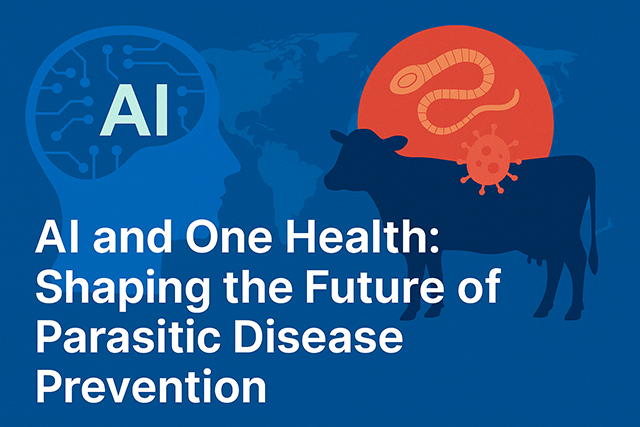
AI and One Health: Shaping the future of parasitic disease prevention


By integrating AI with One Health principles, parasitology can now tackle zoonotic diseases swiftly, accurately, and sustainably worldwide.
The One Health framework emphasises the interconnectedness of human, animal, and environmental well-being. According to the World Health Organization (2021), “the health of humans, domestic and wild animals, plants, and the broader environment (including ecosystems) are intimately linked and rely on each other.” Practically, this indicates that maintaining human health requires protecting animals, ecosystems, and the fragile relationships that unite them. Effective collaboration among doctors, veterinarians, ecologists, and environmental scientists is crucial for preventing, identifying, and managing diseases that cross species boundaries or arise from ecological disturbances.
Parasitology, the study of parasites and their hosts, illustrates the concept of One Health. Many parasites are zoonotic, meaning they can transfer between animals and humans through shared ecosystems. Factors such as livestock management, sanitation, food habits, and environmental changes influence the spread of infection. Parasitology reveals how human actions and environmental changes shape disease patterns. Yet, conventional diagnostic methods remain time-consuming and highly specialised. With the rise of Artificial Intelligence (AI), the field is entering a new era of speed, precision, and innovation.

AI technology breakthroughs mark a decisive shift from reactive responses to proactive prevention, showing how technology can bridge gaps between laboratory science, field ecology, and public health. AI is transforming how parasite detection is performed under the microscope.
Traditionally, specialists manually examined blood or stool samples for tiny organisms such as Plasmodium, which causes malaria, or Giardia. Now, AI-driven computer vision can evaluate digital microscope images in seconds, similar to facial recognition technology on smartphones. These systems, trained on thousands of images, can detect parasites with high accuracy, even when infections are mild or multiple species are present. Tools like ParasNet can instantly identify waterborne parasites.
In Brazil, systems such as Automated Diagnosis of Intestinal Parasites utilise AI to analyse tens of thousands of stool samples each month—automatically filtering out slides without parasites, allowing technicians to focus on confirmed cases. This approach not only accelerates diagnosis but also reduces errors and expands access to reliable testing, particularly in areas with limited medical resources.

Beyond diagnosis, AI helps epidemiologists predict and prevent parasite outbreaks by analysing the movement of infections through ecosystems. Combining data on weather, land use, population density, and insect activity, AI identifies risk zones and gives early warnings before outbreaks. For example, AI models predict where snail populations with schistosomiasis might thrive after rainfall, or map future malaria hotspots as temperatures rise. These insights enable public health teams to act early with targeted control, preventive treatments, or awareness programmes, long before diseases spread.
AI has further transformed the identification of parasites and vectors. Species such as Anopheles mosquitoes or Leishmania parasites appear almost identical under a microscope and require expert taxonomists for precise classification. AI systems address this challenge by analysing microscopic features in shape, texture, and sound patterns. Deep learning models can now distinguish mosquito species based on wing structure or flight sounds, enhancing vector monitoring and control efforts. This advancement aligns with One Health goals by reducing the spread of zoonotic diseases and promoting environmental harmony.
At the molecular level, AI accelerates the discovery of drugs and vaccines. Instead of experimentally testing thousands of compounds, scientists employ AI to virtually screen millions of molecules and identify those most effective against parasites such as Plasmodium, Trypanosoma, or Leishmania. These AI models can also evaluate safety, decreasing the time and expense involved in developing new treatments. In genetics, AI analyses parasite DNA and protein data to identify potential targets for vaccines and therapies, enabling the development of more precise and sustainable solutions for humans and animals.

Using AI in parasitology presents several challenges, including the need for large and diverse datasets, limited digital infrastructure, and a shortage of trained personnel, particularly in low-resource settings. Models built in one region may underperform elsewhere due to environmental and biological variations, while concerns about data privacy, interoperability, and algorithmic bias persist when integrating information from humans, animals, and the environment. Overcoming these hurdles requires global collaboration, open data sharing, and strong validation frameworks.
Despite these challenges, the future of AI in parasitology lies in creating advanced, interconnected systems that bring the One Health vision to life through portable diagnostics, federated learning, and predictive models —enabling early detection, targeted intervention, and more intelligent disease control worldwide.
No Techcircle journalist was involved in the creation/production of this content.


Ekaa Desai and Ashish Desai
Ashish Desai is an Associate Professor of Information Management and Analytics at the S.P. Jain Institute of Management and Research (SPJIMR), and Ekaa Desai is a BVSC & AH student at Mumbai Veterinary College.
